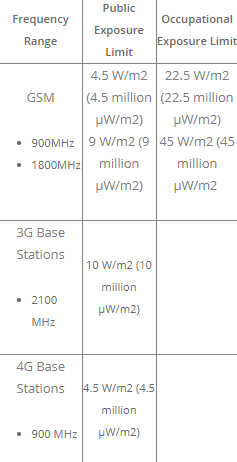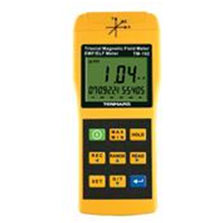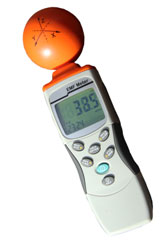How To Measure EMR
How To Measure EMF/EMR
Building biologists generally measure EMF/EMR in three different ways:
- AC Magnetic Fields - with a Gauss Meter
- Radio Frequencies - with a Radio Frequency (RF) meter
- AC Electrical fields - measuring body voltage with a multimeter
AC Magnetic Fields
AC Magnetic Fields (Low frequency - 50 Hz) are measured with a Gauss Meter and are measured in milligauss (mG)
These include EMFs coming from power lines, sub stations, household or industrial wiring, lighting, building power meter boxes and all electrical equipment and appliances. Anything that runs on mains AC electricity can be measured by a Gauss Meter for potentially harmful low frequency magnetic fields. A wide range of health complaints and diseases have been linked to long term exposure to high level AC magnetic fields. More serious conditions include childhood leukemia, breast cancer and immune-related disorders.
Disease: Childhood Leukaemia / Magnetic Field Level: 2 to 4 mG
Disease: Miscarriage / Magnetic Field Level: 16mG
Disease: Breast Cancer / Magnetic Field Level: 12mG
Source: Healthy Home, Healthy Family by Nicola Bijlsma
The less time spent in high level AC magnetic fields the better. Typical danger spots include sitting or sleeping against a wall that backs on to a fridge. Electric motors such as those in fridges throw out a powerful magnetic field which will travel through virtually anything including thick concrete or metal walls. Another area of concern is sleeping or working in a room near the house's power meter box. Move your bed or chair away from the meter box so you are not bathing in a huge AC magnetic field. As shielding is not an option for magnetic fields, simply remove the source or remove yourself away from the source. Luckily magnetic fields usually only extend a few feet from the source and the strength drops off very quickly.
Use a Gauss Meter to discover the AC magnetic hotspots to avoid in your home or workplace. Especially check areas where you spend a lot of time e.g.: your bed, favourite chair etc. Make sure you check for magnetic fields from clock radios and phone chargers, pluswiring in the wall at your bed head.
While you can measure the magnetic field coming from a building's power meter box, a gauss meter will not measure radio frequencies being emitted by a smart meter, for this you need a Radio Frequency Meter (see below)
What are safe levels of low frequency EMF?
According to Building Biology the following levels should be noted:
✔ No concern - under 0.2 mG
✔ Slight concern - 0.2 - 1 mG
✖ Severe concern - 1 - 5 mG
✖ Extreme concern - above 5 mG
*measurement unit is milligauss (mG)
Radio Frequencies
Radio Frequencies (High frequency - typically 10MHz - 8GHz) are measured with a Radio Frequency (RF) Meter
Devices that emit RF include mobile phones, cordless phones and their base stations, WiFi routers and devices, Bluetooth devices, smart meters, microwave ovens, GPS devices, baby monitors and communication towers, “smart” or WiFi-enabled devices, to name a few.
On May 31, 2011 the World Health Organisation (WHO) International Agency for Research on Cancer (IARC), officially classified all radio frequency electromagnetic fields as a (class 2B) “Possible Human Carcinogen”. Read the press release here.
There is a wealth of research linking radio frequencies to many health disorders including:
- Sleep problems (insomnia, difficulty falling asleep, night waking, nightmares)
- Stress, agitation, anxiety, irritability
- Headaches, sharp pain or pressure in the head
- Ringing in the ears, ear pain, high pitched ringing
- Concentration, memory or learning problems
- Fatigue, muscle or physical weakness
- Disorientation, dizziness, or balance problems
- Eye problems, including eye pain, pressure in the eyes,
- Cardiac symptoms, heart palpitations, heart arrhythmias, chest pain
- Leg cramps, or neuropathy
- Arthritis, body pain, sharp, stabbing pains
- Nausea, flu-like symptoms
- Sinus problems, nose bleeds
- Respiratory problems, cough, asthma
- Skin rashes, facial flushing
- Urinary problems
- Endocrine disorders, thyroid problems, diabetes
- High blood pressure
- Changes in menstrual cycle
- Hyperactivity or changes in children’s behaviour
- Seizures
- Recurrence of cancer
Use a Radio Frequency (RF) Meter to discover the RF hotspots in your home or work place. Once you identify the RF source you can take action to minimise your exposure to it - ideally remove it by either disconnecting or removing the RF emitting device.
Measuring RF fields is very complex. While many affordable RF meters will give a good indication of the presence of far-field RF, they are not completely accurate. Also, they are not meant for measuring RF close to the source (near-field) and cannot be used for working out the SAR (Specific Absorption Rate) of mobile phones. Measuring near-field RF requires very expensive specialised equipment operated by highly trained technicians.
Exposure Standards for Radio Frequencies
For radio frequencies between 3KHz and 300GHz many countries, including Australia, have adopted standards set by the International Commission on Non-Ionising Radiation (ICNIRP) which have been endorsed by WHO.
The exposure guidelines set by ICNIRP and adopted by ARPANSA (Australian Radiation Protection and Nuclear Safety Agency) are listed as:
 According to many EMF experts the current standards are completely inadequate to protect human health. The Australian College of Environmental Sciences www.aces.edu.au recommends the following levels of Pulsed RF for living spaces:
According to many EMF experts the current standards are completely inadequate to protect human health. The Australian College of Environmental Sciences www.aces.edu.au recommends the following levels of Pulsed RF for living spaces:
Living areas: <10µW/m2
Sleeping areas: <5µW/m2
As you can see Building Biology standards are millions of times lower than those set by the authorities.
What are safe levels of high frequency RF?
According to Building Biology the following levels should be noted:
✔ No concern - under 0.1 uW/m2
✔ Slight concern - 0.1 – 10 uW/m2
✖ Severe concern - 10 – 1000 uW/m2
✖ Extreme concern - above 1000 uW/m2
* measurement unit is microwatts per square metre – uW/m2 (Note: mW/m2 = milliwatts/m2. 1 milliwatt = 1000 microwatts)
Electrical Fields
Like 50 Hz magnetic fields, electrical fields emanate from many AC power sources. They are inherently tricky to measure. Just the presence of a human body will affect the reading on many electrical field meters. Instead of measuring electrical fields directly, many building biologists instead measure AC body voltage with a Multimeter.
The human body naturally has a minute DC current. All AC voltage is man-made and therefore un-natural in the human body. Because we live and work in close proximity to AC power (building wiring, power lines, appliances etc) and our bodies are conductive we inevitably end up with elevated AC voltage readings in our bodies. We are not aware of any studies indicating a safe level of AC voltage in the body so the lower the better. Here is a possible guideline.
What are safe levels of AC voltage in the human body?
According to Building Biology the following levels should be noted:
✔ No concern – under 0.1V AC
✔ Slight concern – 0.1 – 2V AC
✖ Severe concern – 2V – 15V AC
✖ Extreme concern – above 15V AC
* measurement unit is Volts (V) AC
Protecting yourself from EMR
Once you have identified the levels of EMR you are being exposed to, then:
- Remove the source of EMR (where possible);
- Remove yourself from the source of EMR (where 1 is not possible);
- When 1 and 2 are not possible, minimise your EMR exposure as much as possible, and;
- Protect yourself and loved ones from all EMR
Visit our Reducing Exposure page for more information on how to protect you and your family from EMR and save 15% on our Complete Test Kit today.








